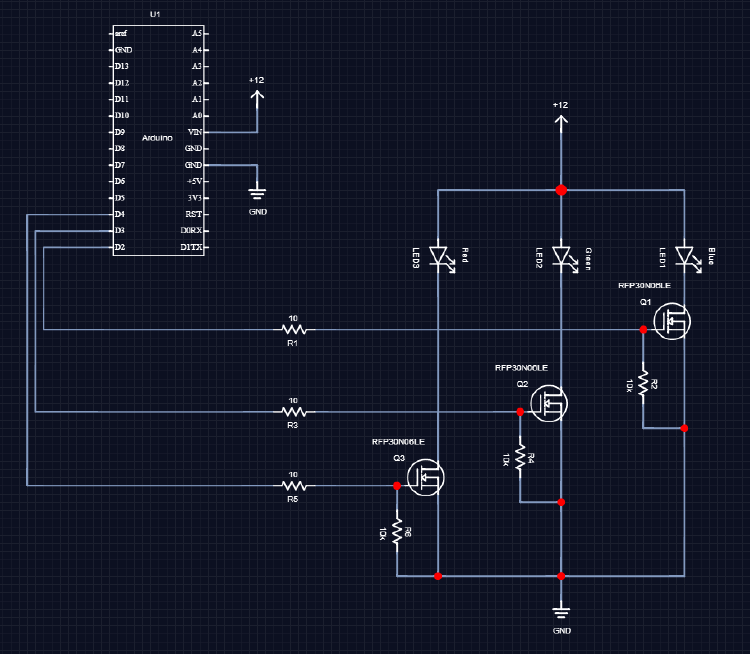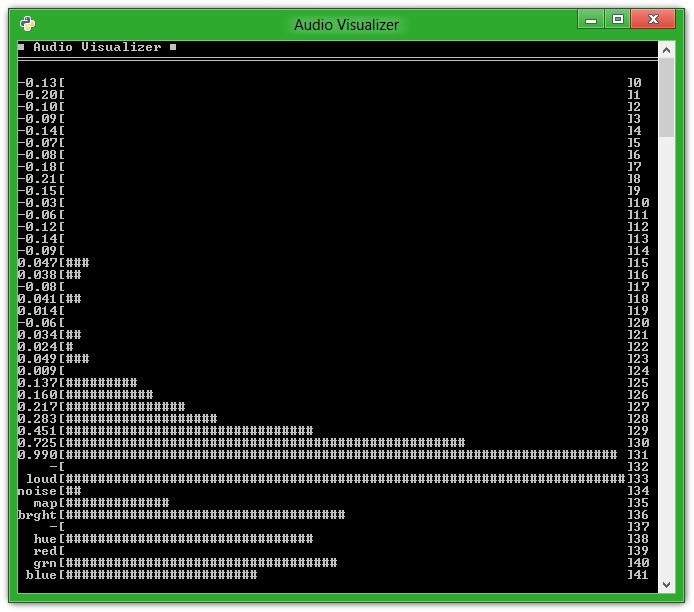
Github: jorticus/audiovis
Overview
I developed a sound reactive system to go with a Chinese 5m RGB light strip , which easily lights up the whole room in any colour I want.
It detects the noisiness of the room, and changes colour depending on how noisy it is. When the room is quiet, the room remains a deep blue colour, but it progresses to yellow and red as the room gets noisier.
The system consists of an Arduino and a Python script running on my computer, which listens to an audio input and performs some processing on it to determine the loudness of the room.
Electronics
The electronics are relatively simple, as all they need to do is receive commands from the computer and drive the LEDs

Arduino
The arduino code is really simple, it just reads 3 binary values from the computer over a serial port, and updates the RGB PWM outputs. I’m using a very simple protocol consisting of 4 bytes, using the first byte to sync the packet in case it gets out of sync.
// Update LED brightness
void loop() {
if (Serial.available()) {
if (Serial.read() == 'X') { // sync byte
while (!Serial.available());
analogWrite(red_led, Serial.read());
while (!Serial.available());
analogWrite(green_led, Serial.read());
while (!Serial.available());
analogWrite(blue_led, Serial.read());
}
}
}

The python code does all the heavy audio DSP, and contains the algorithm for determining the colour of the LEDs.
This process is explained below…
Capturing Audio
To capture audio using python, I’m using pyAudio . It makes it very easy to connect to an audio device and stream data.
To open an audio stream using pyAudio:
import pyaudio
SAMPLE_RATE = 44100
BUFFER_SIZE = 2**11
p = pyaudio.PyAudio()
stream = p.open(format=pyaudio.paInt16,channels=1,rate=SAMPLE_RATE,\
input=True,output=False,frames_per_buffer=BUFFER_SIZE)
DSP
First we read an audio sample, and convert it to something python can use
import struct
# Get audio sample
buf = stream.read(BUFFER_SIZE)
data = scipy.array(struct.unpack("%dh"%(BUFFER_SIZE),buf)) #h: unsigned short, 2 bytes per sample
Then we generate an FFT using scipy’s FFT library. I’m only interested in the amplitudes, so calling abs() on the samples will produce an array of amplitudes.
from scipy.fftpack import fft, fftfreq
import scipy
def get_fft(data):
""" Run the sample through a FFT """
FFT = fft(data) # Returns an array of complex numbers
freqs = fftfreq(BUFFER_SIZE, 1.0/SAMPLE_RATE) # Returns an array containing the frequency values
y = abs(FFT[0:len(FFT)/2])/1000 # Get amplitude and scale
y = scipy.log(y) - 2 # Subtract noise floor (empirically determined)
return (freqs,y)
freqs,y = get_fft(fdata)
The FFT is then averaged into smaller chunks, which makes it easier to display and process.
# Average into chunks of N
N = 200
yy = [scipy.average(y[n:n+N]) for n in range(0, len(y), N)]
yy = yy[50:] # Discard half of the samples, as they are mirrored
Sidenote: You could probably skip using FFT and just take the absolute average of the signal, depending on how you want the system to react.
RGB Algorithm
The loudness level is determined using a threshold detection system
def thresh(val, threshold):
val -= threshold
if val < 0: val = 0
val *= (1.0/threshold)
return val
CHANNEL = 1 # which FFT frequency to respond to
GAIN = 1.5 # audio gain
THRESHOLD = 0.15 # audio trigger threshold
loudness = thresh(yy[CHANNEL] * GAIN, THRESHOLD)
ATTACK = 0.004 # amount of increase with loudness
DECAY = 0.003 # amount of decay
noisiness -= DECAY
noisiness += loudness * ATTACK
noisiness = limit(noisiness, 0.0, 1.0)
mapping = (10 ** limit(noisiness, 0.0, 1.0)) / 10.0 # Power function
mapping = mapping * 1.1 - 0.11 # Linear correction
Finally this is turned into a hue value
MIN_HUE = 200 # Aqua
MAX_HUE = 0 # Red
hue = mapval(limit(noisiness, 0.0, 1.0), 0.0, 1.0, MIN_HUE, MAX_HUE)
Now we can update the LEDs
red,green,blue = hsv2rgb(hue,1.0,brightness)
rgb_update([int(red),int(green),int(blue)])
Communication
I’m using a very simple protocol, and pyserial to communicate with the arduino.
import struct
import serial
ser = serial.Serial('COM3') # Change as appropriate
def tobyte(i):
i = int(i)
if i < 0: i = 0
if i > 255: i = 255
return i
def rgb_update(color):
r = tobyte(color[0])
g = tobyte(color[1])
b = tobyte(color[2])
packet = struct.pack('cBBB', 'X', r,g,b)
#print packet
self.ser.write(packet)
Resources
Footnote
If you’d like to know more about this project, feel free to contact me!
Complete source code is available on github:



